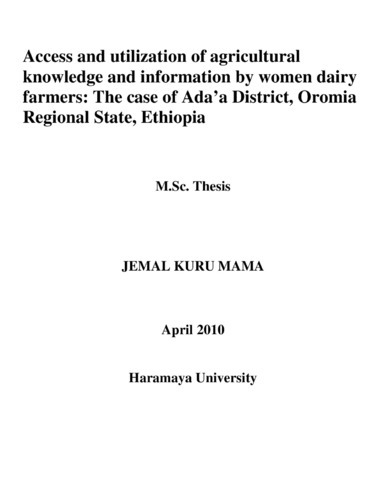Access and utilization of agricultural knowledge and information by women dairy farmers: The case of Ada’a District, Oromia Regional State, Ethiopia
Abstract
Nevertheless, the significant role of women in dairy production, processing and marketing, so far no systematic study has been undertaken with regard to their access and utilization of knowledge and information and the factors influencing the same. Specifically the research attempts to answer four important questions: i).What is the sources of knowledge and information, inputs and services for women dairy farmers? ii) How far women dairy farmers are able to access and utilize the available knowledge and information? iii) What are the constraints and opportunities for creating enhanced knowledge and information flows amongst women dairy farmers? And iv) What are the factors influencing the access to and utilization of knowledge and information? Four stage sampling procedures were used in which both non-random and random sampling procedures were followed to stratify dairy production systems into peri-urban and rural systems, selection of two kebeles from each sub system and120 respondents. Both quantitative and qualitative data were collected from primary and secondary source. The quantitative data were analyzed using descriptive statistics like frequency, mean, percentage, standard deviation, chi-square,t-test and F-test while persons’ correlation and multiple linear regression analysis, were used to test the magnitude of the relationship and influence between dependent and independent variables. The study has investigated that neighbors and friends, public institutions, NGOs, cooperative and private sector involved in the activities of knowledge and information dissemination, input supply and provision of services for smallholder dairy farmers. With regard to access and utilization of knowledge/information, variations were observe among the sub systems, where the majority or 92.31and 61.5% of rural producers belonged to low level of overall access and utilization, respectively. In the study area, opportunities like rapid urbanization and population increase, availability of services, strong linkage, favorable national policy, technological options and farmer’s willingness to pay exists for achieving productivity improvement and market-orientation in smallholder dairy systems. Furthermore, the research identified feed scarcity, poor breeding, veterinary and credit services and access to markets as supply-side constraints while high marketing costs, highly seasonal price fluctuations and safety and quality concerns are demand-side constraints. Extension participation, family education, Medias, innovation proneness and cosmpoliteness were also found to be significant in explaining dependent variables of access and utilization of dairy knowledge and information while livestock holding and distance from market had negative influence. In summary, in the context of Ada’a, provision of technical and advisory services on dairy production were not biased towards MHHs, rather the services are lacking for the livestock sub-sector in general and dairy in particular. Therefore, purposeful focus has to be given on knowledge and information sources by strengthening pluralistic advisory service delivery mechanism in a coordinated and networked way. In addition, by considering the significant explanatory variables, ensuring the transfer of knowledge and services towards smallholder dairy systems for improving access to and utilization of knowledge and information among women dairy farmers in the study area is important.

